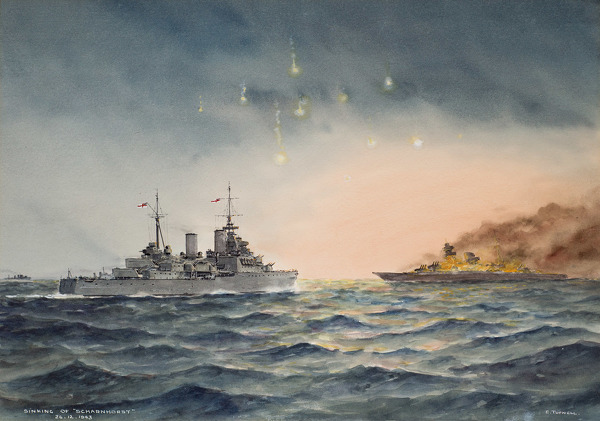
£1,575
Sinking of "Scharnhorst" 26.12.1943
Framed (ref: 7034)
Signed and inscribed with title
Tags: Eric Erskine Campbell Tufnell watercolour maritime war World War II Paintings by British Artists

Tags: Eric Erskine Campbell Tufnell watercolour maritime war World War II Paintings by British Artists
Provenance: The Artist's Estate; Private collection
Exhibited: WW2 - War Pictures by British Artists, Morley College London, 28 October -23 November 2016, cat 22.
Literature: WW2 - War Pictures by British Artists, Edited by Sacha Llewellyn & Paul Liss, July 2016, cat 22, page 59.
The German battleship Scharnhorst was sailing to attack an Allied convoy which loaded with supplies for the Soviet Union when a superior British force met her off the North Cape (Norway). Of the 1,968 on board, only 36 men survived. The ship in the foreground is a light cruiser armed with 6” guns in triple turrets. The scene shows the last hours of the action, when the British fired starshells to illuminate their target. The cruiser HMS Belfast, now moored in the Pool of London, also had an important role in the battle.
Starting as a Cadet in 1903 at the age of fifteen Tufnell had a long - though not always distinguished - career in the Navy. His Naval Log and Journal covering the years 1904-7 illustrated with sketches, maps, sectional drawings of ships, photographs and newspaper cuttings is now in the Surrey County Archives. Sketching was an activity he continued throughout his career. During WW1 he served CO of D4 which had HMS Vulcan as its depot ship on the Firth of Forth and was part of the 3rd Submarine Flotilla. He was described by a senior officer as "having an artistic temperament but does not appear to mind discomfort".
Later during WW1 he was posted to HMS Victory at Portsmouth for "special services in motor launches of hydrophonic flotilla" and In December 1918 he was given command of M18, a shore bombardment Monitor with a huge 9.2 inch Gun which served in the Baltic from April to June 1919. Tufnell was "mentioned in Despatches" (MID) for "services to Russia" in the 12 December issue of the London Gazette and a year later, to the embarrassment of the Foreign Office, was awarded the Order of St Stanislaus (2nd Class, with swords) by the defeated White Russian Army (the announcement had to be censored from the London Gazette). After WW1 he was posted to the aircraft carrier HMS Argus while training under the RAF at Lee-on-Solent as an Observer. In December 1926 he was sent as "acting Observer" to HMS Furious with the Atlantic Fleet and in April 1927 to Farnborough for a course at the RAF School of Photography. He retired from the Royal Navy in 1929, in his early 40's, with the intention of taking up painting full time.
A prolific artist many commissions were secured through the of Saville Row naval outfitters, Gieves and Hawkes, whose naval officers customers asked Tufnell to paint meticulously accurate water colours of the ships on which they served. We are grateful to Bill Forster from Holywell House Publishing for his help. To read full biography; http://www.holywellhousepublishing.co.uk/Tufnell.html